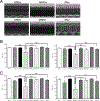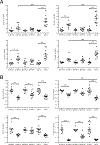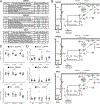Cardiomyocyte glucocorticoid and mineralocorticoid receptors directly and antagonistically regulate heart disease in mice
- PMID: 30992401
- PMCID: PMC7082727
- DOI: 10.1126/scisignal.aau9685
Cardiomyocyte glucocorticoid and mineralocorticoid receptors directly and antagonistically regulate heart disease in mice
Abstract
Stress is increasingly associated with heart dysfunction and is linked to higher mortality rates in patients with cardiometabolic disease. Glucocorticoids are primary stress hormones that regulate homeostasis through two nuclear receptors, the glucocorticoid receptor (GR) and mineralocorticoid receptor (MR), both of which are present in cardiomyocytes. To examine the specific and coordinated roles that these receptors play in mediating the direct effects of stress on the heart, we generated mice with cardiomyocyte-specific deletion of GR (cardioGRKO), MR (cardioMRKO), or both GR and MR (cardioGRMRdKO). The cardioGRKO mice spontaneously developed cardiac hypertrophy and left ventricular systolic dysfunction and died prematurely from heart failure. In contrast, the cardioMRKO mice exhibited normal heart morphology and function. Despite the presence of myocardial stress, the cardioGRMRdKO mice were resistant to the cardiac remodeling, left ventricular dysfunction, and early death observed in the cardioGRKO mice. Gene expression analysis revealed the loss of gene changes associated with impaired Ca2+ handling, increased oxidative stress, and enhanced cell death and the presence of gene changes that limited the hypertrophic response and promoted cardiomyocyte survival in the double knockout hearts. Reexpression of MR in cardioGRMRdKO hearts reversed many of the cardioprotective gene changes and resulted in cardiac failure. These findings reveal a critical role for balanced cardiomyocyte GR and MR stress signaling in cardiovascular health. Therapies that shift stress signaling in the heart to favor more GR and less MR activity may provide an improved approach for treating heart disease.
Copyright © 2019 The Authors, some rights reserved; exclusive licensee American Association for the Advancement of Science. No claim to original U.S. Government Works.
Conflict of interest statement
Figures










Comment in
-
Balancing stress signalling in the heart.Nat Rev Cardiol. 2019 Jul;16(7):384-385. doi: 10.1038/s41569-019-0207-0. Nat Rev Cardiol. 2019. PMID: 31068688 No abstract available.
Similar articles
-
Deletion of the Cardiomyocyte Glucocorticoid Receptor Leads to Sexually Dimorphic Changes in Cardiac Gene Expression and Progression to Heart Failure.J Am Heart Assoc. 2019 Aug 6;8(15):e011012. doi: 10.1161/JAHA.118.011012. Epub 2019 Jul 17. J Am Heart Assoc. 2019. PMID: 31311395 Free PMC article.
-
Essential role of stress hormone signaling in cardiomyocytes for the prevention of heart disease.Proc Natl Acad Sci U S A. 2013 Oct 15;110(42):17035-40. doi: 10.1073/pnas.1302546110. Epub 2013 Sep 30. Proc Natl Acad Sci U S A. 2013. PMID: 24082121 Free PMC article.
-
Pressure overload inhibits glucocorticoid receptor transcriptional activity in cardiomyocytes and promotes pathological cardiac hypertrophy.J Mol Cell Cardiol. 2019 May;130:122-130. doi: 10.1016/j.yjmcc.2019.03.019. Epub 2019 Apr 1. J Mol Cell Cardiol. 2019. PMID: 30946837
-
Glucocorticoid signaling in the heart: A cardiomyocyte perspective.J Steroid Biochem Mol Biol. 2015 Sep;153:27-34. doi: 10.1016/j.jsbmb.2015.03.009. Epub 2015 Mar 21. J Steroid Biochem Mol Biol. 2015. PMID: 25804222 Free PMC article. Review.
-
Cardiac GR and MR: From Development to Pathology.Trends Endocrinol Metab. 2016 Jan;27(1):35-43. doi: 10.1016/j.tem.2015.10.001. Epub 2015 Nov 14. Trends Endocrinol Metab. 2016. PMID: 26586027 Review.
Cited by
-
Nicotine-induced adrenal beta-arrestin1 upregulation mediates tobacco-related hyperaldosteronism leading to cardiac dysfunction.World J Cardiol. 2020 May 26;12(5):192-202. doi: 10.4330/wjc.v12.i5.192. World J Cardiol. 2020. PMID: 32547713 Free PMC article.
-
Circadian Regulation of Cardiac Physiology: Rhythms That Keep the Heart Beating.Annu Rev Physiol. 2020 Feb 10;82:79-101. doi: 10.1146/annurev-physiol-020518-114349. Epub 2019 Oct 7. Annu Rev Physiol. 2020. PMID: 31589825 Free PMC article. Review.
-
The Glucocorticoid Receptor in Cardiovascular Health and Disease.Cells. 2019 Oct 9;8(10):1227. doi: 10.3390/cells8101227. Cells. 2019. PMID: 31601045 Free PMC article. Review.
-
GRK5 is an essential co-repressor of the cardiac mineralocorticoid receptor and is selectively induced by finerenone.World J Cardiol. 2022 Apr 26;14(4):220-230. doi: 10.4330/wjc.v14.i4.220. World J Cardiol. 2022. PMID: 35582468 Free PMC article.
-
Deletion of the Cardiomyocyte Glucocorticoid Receptor Leads to Sexually Dimorphic Changes in Cardiac Gene Expression and Progression to Heart Failure.J Am Heart Assoc. 2019 Aug 6;8(15):e011012. doi: 10.1161/JAHA.118.011012. Epub 2019 Jul 17. J Am Heart Assoc. 2019. PMID: 31311395 Free PMC article.
References
-
- Brotman DJ, Golden SH, Wittstein IS, The cardiovascular toll of stress. Lancet 370, 1089–1100 (2007). - PubMed
-
- Steptoe A, Kivimaki M, Stress and cardiovascular disease. Nature reviews. Cardiology 9, 360–370 (2012). - PubMed
-
- Kivimaki M, Pentti J, Ferrie JE, Batty GD, Nyberg ST, Jokela M, Virtanen M, Alfredsson L, Dragano N, Fransson EI, Goldberg M, Knutsson A, Koskenvuo M, Koskinen A, Kouvonen A, Luukkonen R, Oksanen T, Rugulies R, Siegrist J, Singh-Manoux A, Suominen S, Theorell T, Vaananen A, Vahtera J, Westerholm PJM, Westerlund H, Zins M, Strandberg T, Steptoe A, Deanfield J, consortium IP-W, Work stress and risk of death in men and women with and without cardiometabolic disease: a multicohort study. Lancet Diabetes Endocrinol, (2018). - PMC - PubMed
-
- Stewart RAH, Colquhoun DM, Marschner SL, Kirby AC, Simes J, Nestel PJ, Glozier N, O’Neil A, Oldenburg B, White HD, Tonkin AM, Investigators LS, Persistent psychological distress and mortality in patients with stable coronary artery disease. Heart 103, 1860–1866 (2017). - PubMed
Publication types
MeSH terms
Substances
Grants and funding
LinkOut - more resources
Full Text Sources
Molecular Biology Databases
Miscellaneous

